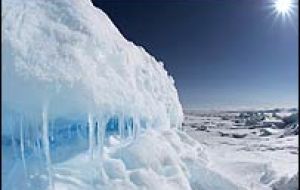MercoPress. South Atlantic News Agency
Huge ice shelf adrift in the Arctic, reports Canada

An ice island the size of a small city is adrift in the Arctic after breaking free from one of Canada's largest ice shelves, reported on Friday Canadian scientists.
The ice island is 37 meters thick and covers an area of 66 square kilometers according to the CanWest News Service. It broke clear from Ellesmere Island, about 800 kilometers south of the North Pole, 16 months ago, triggering tremors so powerful they were picked up by earthquake monitors 240 kilometers away. Scientists have only just released details about the island after piecing together the break-up from seismic monitors and satellite images. Within days of breaking free from its fjord on Ellesmere, the floating ice island had drifted a few kilometers offshore. It traveled west for 50 kilometers until it froze into the sea ice in early winter. The island was part of the Ayles ice shelf, one of six major ice shelves in Canada's Arctic. Scientists believe the shelf's break-up - the largest of its kind in the Canadian Artic in 30 years - is the result of global warming. Artic expert Warwick Vincent, of Laval University in Quebec, said he had never seen such a dramatic loss of sea ice and suggested the break-up indicated that climate change was accelerating. Dr Vincent, who traveled to the ice island, said: "This is a dramatic and disturbing event. It shows that we are losing remarkable features of the Canadian North that have been in place for many thousands of years. We are crossing climate thresholds, and these may signal the onset of accelerated change ahead. "We think this incident is con sistent with global climate change. We aren't able to connect all of the dots ... but unusually warm temperatures definitely played a major role". He added Canada's remaining ice shelves were 90% smaller than when they were first discovered 100 years ago. The huge ice island could pose a hazard to shipping and the oil and gas industry if it drifts further south into the Beaufort Sea in the spring thaw. Laurie Weir, who monitors ice conditions for the Canadian Ice Service, said: "Over the next few years this ice island could drift into populated shipping routes. There's significant oil and gas development in this region as well, so we'll have to keep monitoring its location over the next few years." Ms Weir was poring over satellite images in 2005 when she noticed that the shelf had split and separated. She notified Luke Copland, head of the new global ice laboratory at the University of Ottawa, who initiated an effort to find out what happened. Using US and Canadian satellite images, as well as data from seismic monitors, Professor Copland discovered that the ice shelf collapsed on the afternoon of August 13 2005. "What surprised us was how quickly it happened," he said. "It's pretty alarming. Even ten years ago scientists assumed that when global warming changes occur that it would happen gradually so that perhaps we expected these ice shelves just to melt away quite slowly, but the big surprise is that, for one they are going, but secondly, that when they do go, they just go suddenly, it's all at once, in a span of an hour". The Ellesmere platform was home of unique ecosystems, "with fresh water lakes above and under the ice cap", said Louis Fortier, chief scientist of ArcticNet a Canadian net which researches the Arctic. "The contraction of the ice cap on the island has been going on for 12.000 years but it seems to have accelerated in the last few years", he underlined.




Top Comments
Disclaimer & comment rulesCommenting for this story is now closed.
If you have a Facebook account, become a fan and comment on our Facebook Page!